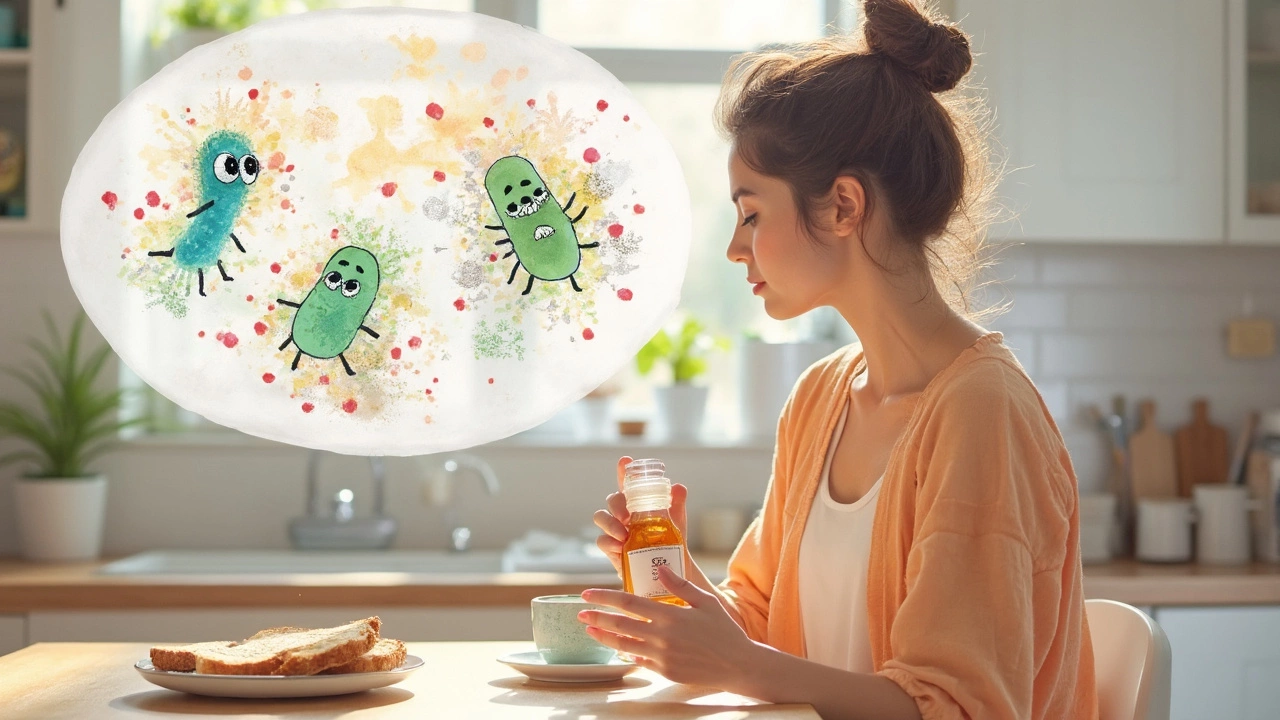 May, 22 2025
May, 22 2025
Your gut does way more than just break down food. Those tiny bacteria living inside you? They keep your immune system working, help make vitamins, and even affect your mood. When antibiotics come into play, things can get ugly—especially if you end up with one of the real gut-busters.
Ever wondered why you get stomach problems after a round of antibiotics? Some antibiotics are like wrecking balls for your gut’s good bacteria. Think bloating, diarrhea, crazy cravings, and even a cranky mood. It’s not all in your head—the balance in your gut gets thrown way off, and that can lead to symptoms that outlast your cold or infection by weeks, sometimes months.
If you’re online, chatting with a doctor about antibiotics, it’s smart to ask about your gut. Some types cause more drama than others. Give your doc as many details as you can, especially if your gut’s touchy to begin with or you’ve had problems before. Just because an antibiotic is commonly prescribed doesn’t mean it’s gentle on your stomach.
- The Gut and Antibiotics: A Rocky Relationship
- Antibiotics That Wreck Your Gut
- Side Effects Nobody Wants
- How to Protect Your Gut During and After Antibiotics
The Gut and Antibiotics: A Rocky Relationship
Your gut is like a busy city loaded with trillions of bacteria and other microbes, and together they make up your microbiome. Most of these microscopic tenants help keep you healthy by breaking down food, fighting off “bad” bacteria, and talking with your immune system. When you take antibiotics, you’re not just killing the germs making you sick—you’re also dropping a bomb on the helpful bacteria in your gut.
That’s the catch with antibiotics: they can’t tell the difference between friend and foe. While they wipe out the bugs causing your infection, they also take out the good guys that keep your gut health in balance. It only takes a few days of the wrong antibiotic to shift your gut microbiome, making it way easier for the troublemakers (like Clostridioides difficile, which can cause nasty diarrhea) to move in.
Yep, your gut really does take the hit. Studies show antibiotics can shrink your gut’s good bacteria by as much as 90% within a week. For some people, the gut bounces back in a month or two, but others end up with changes that stick around for years. That’s where things like food intolerances, stomach pain, and even anxiety can start cropping up.
- Antibiotics don’t target just one type of bacteria—they clear out entire “neighborhoods” in your gut.
- Even one round of antibiotics can cause big drops in diversity, which is a marker of a healthy gut.
- Some antibiotics trigger a domino effect, causing diarrhea, yeast infections, or rashes as sidekicks to the main problem.
Check out how quickly antibiotics can shake up your gut:
| Antibiotic Exposure | Drop in Gut Good Bacteria | Average Gut Recovery Time |
|---|---|---|
| 1 round (7 days) | up to 90% | 4-8 weeks |
| Multiple rounds/year | 70-95% (long term) | Months or longer |
So before you start another antibiotic, it’s worth thinking about what’s at stake for your gut—even if you just want to get over that stubborn sinus infection. There’s no magic fix, but knowing the risks can help you ask smarter questions in your next online doctor consultation.
Antibiotics That Wreck Your Gut
Not all antibiotics mess up your stomach to the same degree. A few are especially notorious for wiping out your gut’s good bacteria along with the bad guys, making you feel far worse than when you started. Let’s call these the gut destroyers.
On top of the list are clindamycin, amoxicillin-clavulanate (Augmentin), and all the so-called broad-spectrum antibiotics like ciprofloxacin and levofloxacin. These meds kill a wide range of bacteria—great if you’ve got a bad infection, but not so great for your microbiome.
"Clindamycin and some broad-spectrum antibiotics carry a higher risk of causing major gut problems, including dangerous C. difficile infections." — CDC report, 2024
If you’ve never heard of C. difficile (C. diff), it’s a bug that can take over when your good bacteria are wiped out. It can cause diarrhea that just won’t quit, sometimes even landing people in the hospital. That’s why doctors hesitate before handing out these antibiotics if they don’t have to.
- Clindamycin: High risk for wrecking your gut, strongly tied to C. diff.
- Amoxicillin-Clavulanate (Augmentin): Often leads to diarrhea and gut discomfort due to its dual action.
- Ciprofloxacin & Levofloxacin: Both are broad-spectrum and can really shift your microbiome fast.
- Cephalosporins (like cefdinir or cefixime): Cause moderate to severe gut upset in some people.
Want to know how big a difference it makes? Here’s a quick look at antibiotics and the chances of them messing up your gut, based on a big review from 2024.
| Antibiotic | Percent of users with gut issues | Common Problems |
|---|---|---|
| Clindamycin | ~20% | Severe diarrhea, C. diff |
| Amoxicillin-Clavulanate | ~15% | Diarrhea, cramping |
| Ciprofloxacin | ~12% | Upset stomach, diarrhea |
| Cephalosporins | ~10% | Loose stool, gas |
| Penicillin (plain) | ~5% | Mild discomfort |
It’s tempting to just take whatever your doctor prescribes, but if your stomach already hates antibiotics, mention your past reactions. A lot of online doctors are open to finding the safest choice for your gut, if possible.

Side Effects Nobody Wants
When your gut is hit by the worst antibiotics, you’re not just looking at a little extra gas. Antibiotics can wipe out the friendly bacteria that keep things running smoothly in your digestive system. That loss can let the bad guys—like harmful bacteria—take over and make you miserable.
The most common side effect? Diarrhea. Doctors see this a lot, especially with antibiotics like clindamycin, amoxicillin-clavulanate, and certain cephalosporins. Sometimes it’s just annoying, but in some cases, it leads to serious infections like C. difficile, or "C. diff" for short, which can land people in the hospital and drag on for months. Watch out if you get watery diarrhea several times a day, or see blood or mucus in your stool. That’s a sign it’s time to call your doctor right away.
There’s more. Ever felt bloated, had stomach cramps, or just felt "off" after finishing antibiotics? That’s your gut flora trying to recover. Some people end up with yeast infections, since the normal bacteria that keep yeast in check are gone. Others notice they can’t digest certain foods the same way for weeks after treatment, leading to food sensitivities or weird cravings.
- Loose stools or diarrhea—can be mild, but sometimes severe and even dangerous.
- Bloating and painful cramps.
- Persistent changes in appetite or cravings (especially sugar).
- Higher risk of yeast infections (vaginal or oral thrush).
- Rare, but real, risk of long-term gut issues like irritable bowel syndrome.
If you take antibiotics and your stomach goes haywire, don’t just wait it out. You might be able to switch to a different med or add probiotics to ease symptoms (but ask your doctor first). And it’s not just about your belly—messing up your gut can affect sleep, energy, and even stress levels.
How to Protect Your Gut During and After Antibiotics
Nobody wants to deal with gut misery after getting treated for something else. The good news? There are things you can do to help your gut bounce back—or even hold up better while you’re still on antibiotics. Here’s what actually helps, and what’s just hype.
First up, ask your doctor if the antibiotic you’ve been given is the worst antibiotic for gut health. Sometimes you really need it, but other times there might be a gentler option that gets the job done just as well. Don’t be scared to bring this up—it’s your gut on the line.
When you’re on antibiotics, simple habits matter. Stay hydrated. Eat small, regular meals. Go easy on greasy foods and super processed stuff—they’re harder on your system when your gut bacteria are out of whack.
- Probiotics: These are supplements or foods (like yogurt with live cultures) that send friendly bacteria into your gut. The trick? Don’t take them at the exact same time as your antibiotics. A couple of hours apart works better. Check for strains like Lactobacillus rhamnosus GG and Saccharomyces boulardii—these have some solid research behind them.
- Fiber-rich foods: Things like oats, bananas, beans, and broccoli are prebiotics, which means they help feed your good gut bacteria and help them grow back faster.
- Skip the sugar overload: Too much sugar helps the bad bacteria (and yeast) win. Cutting back can make it easier for your gut to get back in shape.
- Take the full course: Don’t stop antibiotics early, even if your gut feels better. Stopping too soon can leave the bad bugs behind.
After you finish the medicine, keep eating real, whole foods and kick back on the alcohol for a bit—it can slow down your gut’s recovery. If you’re still not right weeks later, bring it up with your doctor. Sometimes you’ll need a little extra help, especially if you get stuck with diarrhea for more than a few days.
